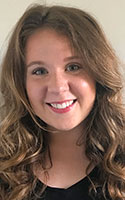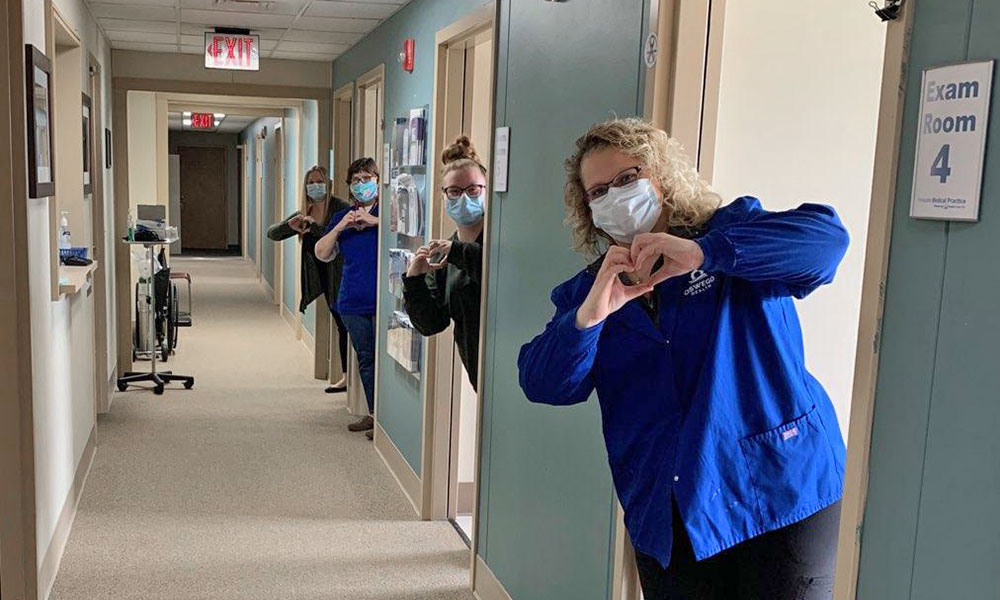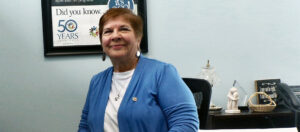The pandemic has been challenging for nurses, but their actions might be inspiring the profession’s next generation
By Ken Sturtz

Last spring, as the pandemic that would kill more than 500,000 Americans enveloped the country’s health care system, Destiny Fitzsimmons prepared to enter the unfolding maelstrom.
Fitzsimmons, of Oswego, was among 36 students who graduated in May from Cayuga Community College’s nursing program. The students were forced to finish their courses for the spring semester through a distance learning format and the traditional nurses’ pinning ceremony was replaced by a socially distanced drive-thru event.
Within days of graduating, Fitzsimmons began working as a graduate nurse in the intensive care unit at Oswego Hospital.
The pandemic has exacerbated a nationwide shortage of nurses and battered the profession like nothing else in recent memory. Over the last year nurses have been forced to adapt constantly to the changing situation. They’ve cared for the sick and comforted the dying. They’ve clocked long hours on the job and exposed themselves and their families to possible infection.
For their efforts, they’ve been widely hailed as heroes. It remains to be seen, however, if the good will toward nurses and the attention brought to the profession by the pandemic encourage more people to enter the field.
For her part, Fitzsimmons never expected to start off in nursing in the midst of a global pandemic. When she started her challenges were twofold: She had to learn the basics of nursing as well as the policies and procedures for dealing with the coronavirus. That wasn’t an easy task since the coronavirus had plunged health care professionals into largely uncharted territory, meaning policies and procedures were constantly changing.
“It was all trial and error,” she said. “Everything was still new.”
She was helped by the fact that Oswego Hospital initially didn’t have a large influx of COVID-19 patients. That allowed her more time to learn. She said she also benefited from working with a supportive team in the intensive care unit that wouldn’t hesitate to help each other when they needed it.
Fitzsimmons wasn’t alone in needing to learn quickly, however. Even veteran health care workers had no experience dealing with such a widespread, prolonged crisis.
“Well I think overall, like with everybody else who lived through the pandemic, initially at least it was pretty scary,” said Scott Jessie, executive director of nursing for Upstate Medical University. “This was a brand-new thing for everybody.”
Medical professionals deal with infectious diseases all the time, he said, but a global pandemic was a completely different proposition. There was a great deal of stress initially as hospital officials made changes quickly and staff had to be flexible.
As COVID-19 patients began arriving last year, hospital staff began grappling with many challenges. Jessie said one in particular was largely unexpected, but became one of the most agonizing aspects for nurses.

“Nursing is always at the bedside for the good and the bad of what people go through in health care, but the pandemic was different,” Jessie said. “Honestly, one of the most difficult challenges was people who ended up coming to the hospital and passed away and many times their family could not be here.”
Health care workers inevitably deal with death, but this was different. In hospitals and nursing homes, families weren’t allowed to visit for fear of spreading the coronavirus. Jessie said nurses rose to the occasion, communicating with families frequently about their loved ones and trying to offer comfort to their patients.
“They did everything they possibly could for those families,” he said.
There were other, less agonizing, challenges that had to be dealt with. Valerie Favata, vice president and chief nursing officer at Oswego Health, said hundreds of staff were furloughed or ordered to work from home, but the nursing staff had to face the crisis head-on from the start.
Initially many people were concerned about becoming infected, especially as health care facilities across the country were facing a severe shortage of personal protective equipment. Concerns about running out of PPE only stoked fears among nurses of becoming infected and taking the virus home to family, Favata said.
She said she was proud to see the hospital’s nursing staff pull together and work through their fears about dealing with the coronavirus.
“I think that every day during the pandemic even though people were physically and emotionally exhausted, because everybody was, that you went home at the end of the day knowing you were doing your part to make it better,” she said.
Another unexpected issue popped up when the hospital shut down elective surgery, Favata added. Nurses were redeployed from their normal specialties to areas where they were needed, such as the emergency room or the intensive care unit.
Many of those nurses hadn’t worked in those types of units in years, if ever, said Ryan French, director of ICU and respiratory therapy at Oswego Health.
In the intensive care unit especially, nurses unfamiliar with that environment needed help getting up to speed. For a nurse focused on a specialty in the operating room, for example, treating critical patients in the intensive care unit can be a significant adjustment. French said the nurses familiar with the intensive care unit did an excellent job supporting their colleagues and helping them learn the ropes.
“In the spring we really got a chance to help those nurses develop their confidence with those types of patients,” French said. “We’ve all depended on each other to get through it. I don’t think I would have been able to get through some of this stuff without the people that I do work with.”
It can be easy to overlook the importance of camaraderie between health care workers. But Jessie likened nursing to law enforcement and firefighting in that they often see and deal with things that many professions don’t and develop close ties.
“I do think a big piece of how people got through it is that bonding with their teams,” he said. “I think the pandemic probably really solidified for a lot of people why they do the work they do.”
Upstate officials were especially sensitive to the physical, mental and emotional strain on staff since the hospital ended up caring for a larger number of coronavirus patients than other hospitals, Jessie said.
Early on, Upstate canceled or slowed down elective surgeries to create capacity in its system. They also relocated surgical staff and ambulatory staff to help on the hospital floors. And they were careful to ensure no one had the toughest jobs indefinitely.
“We have had the ability to switch which ICUs are designated as COVID to give the staff a break,” Jessie explained. “We were very purposeful about that because we knew we needed to give the staff break.”
All hospitals and health care facilities experience staffing shortages from time to time. They often fill the gap by having staff work overtime or by bringing in temporary travel nurses from other parts of the country. The pandemic made those traditional solutions unworkable.
“For the first time in everyone’s career the entire U.S. had the same problem at the same time, Jessie said. “And that’s never really happened before.”
Travel nurses became extremely difficult to hire and overworked staff were already putting in long hours.
The shortage of nurses in the U.S. is only expected to intensify in coming years as baby boomers age and the need for health care grows, according to the American Association of College of Nursing.
People are entering the nursing field, but nursing school enrollment isn’t growing fast enough to meet the demand. Whether the pandemic ultimately pushes a significant number of nurses to leave the field is an open question. Regardless, the average age of a registered nurse is 50 years old, meaning there is likely to be a wave of retirements in the next 15 years.
According to employment predictions by the Bureau of Labor Statistics, registered nursing is listed among the top occupations in terms of job growth through 2029. The workforce is expected to grow from 3 million in 2019 to 3.3 million in 2029. When retirements and people leaving the field are included, there are likely to be more than 175,000 openings for nurses each year through 2029.
Recruiting nurses was enough of a challenge before the pandemic that many health care organizations developed programs to target people considering a career in health care. Oswego Health does outreach with high school students, encouraging them to enter a program to expose them to the health care field. Hiring incentives such as signing bonuses and tuition reimbursement are also used.
There may be some signs already that the work of nurses in the pandemic is inspiring others to enter the profession. A survey by the American Association of Colleges of Nursing found enrollment in baccalaureate nursing programs increased nearly 6% in 2020, to 250,856.
“I do think it is very similar to the 9/11 effect because people did really see what health care workers do and what they go through,” Jessie said. “It’s a noble calling and people really saw that with this pandemic.”



